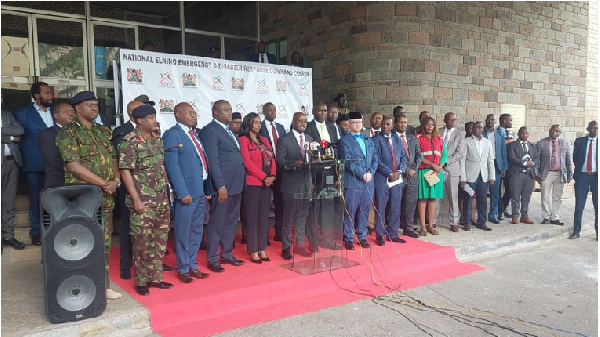
NAIROBI, Nov 30 (NNN-KBC) — Kenya’s National El Niño Steering Committee said floods have killed a total of 120 people, with Tana River, Garissa, Wajir and Mandera counties worst hit. Nine other counties are on high alert.
Addressing the media, Principal Secretary, of the Ministry of Internal Security and National Administration Dr Raymond Omollo announced that Isiolo, Kwale, Homabay, Makueni, Tharaka Nithi, Lamu, Taita Taveta, Meru and Kisumu were on high alert.
“From October to date, 120 people have unfortunately died and their families duly informed. Nine bodies were retrieved in Mombasa while four bodies were recovered from Lake Victoria. 89,098 households have been displaced and (are) being hosted in 112 camps established in affected counties. Through our search and rescue efforts, 2,058 people have been assisted and undergoing medical checkups at the camps set up,” announced Dr Omollo.
“The government has similarly distributed food, water and non-food items to several counties including Busia, Marsabit, Isiolo, Mandera, Garissa, Wajir, Tana River, Lamu, Kitui and Mombasa,” he added.
Dr Omollo also announced the setting up of a Command Centre for Emergency Response, communication and Information at Nyayo House, which will coordinate all government activities in responding to and managing the flood disaster.
The centre will provide emergency updates on the floods every day at 3 pm until the situation subsides.
The centre will be responsible for documenting and reporting flood-related information, “providing early warning information, flood alerts, flood preparedness, safety and emergency response information to stakeholders and the public, and mobilising resources and combine capacities at all levels of Government to respond to crises.”
The centre will also “liaise with agencies in national and county governments to better respond to emergencies and coordinate interventions including rescue operations, humanitarian aid and infrastructure restoration to manage the different situations across the Country.”
The steering committee has also partnered with 11 ministries, the Kenya Defence Forces, the National Police Service, the Kenya Wildlife Service, the Kenya Coast Guard Service and the National Youth Service to improve response to flood emergencies.
The ministries are Defence, Interior and National Administration, Roads and Transport, Health, Education, Water, Sanitation and Irrigation, Lands, Public Works, Housing and Urban Development, Agriculture and Livestock Development, Energy and Petroleum, EAC, ASALS and Regional Development and Labour and Social Protection.
The government has also sought additional support from other humanitarian agencies such as the Kenya Red Cross Society and the World Food Programme (WFP). Other partners have also been activated to support the delivery of essential aid via road and air.
The committee has also partnered with the Council of Governors and the Kenya Red Cross Society to supplement emergency response and interventions.
It has also activated Disaster Response and Security Committees in counties to coordinate interventions and address disasters in areas where the need will emerge.
“Saving lives and reducing the impact of the El Nino rains through early warning and disaster monitoring remains the Government’s top priority. Having every actor and stakeholder working in sync is the surest way of mitigating and responding to the emergency,” said Dr Omollo. — NNN-KBC






